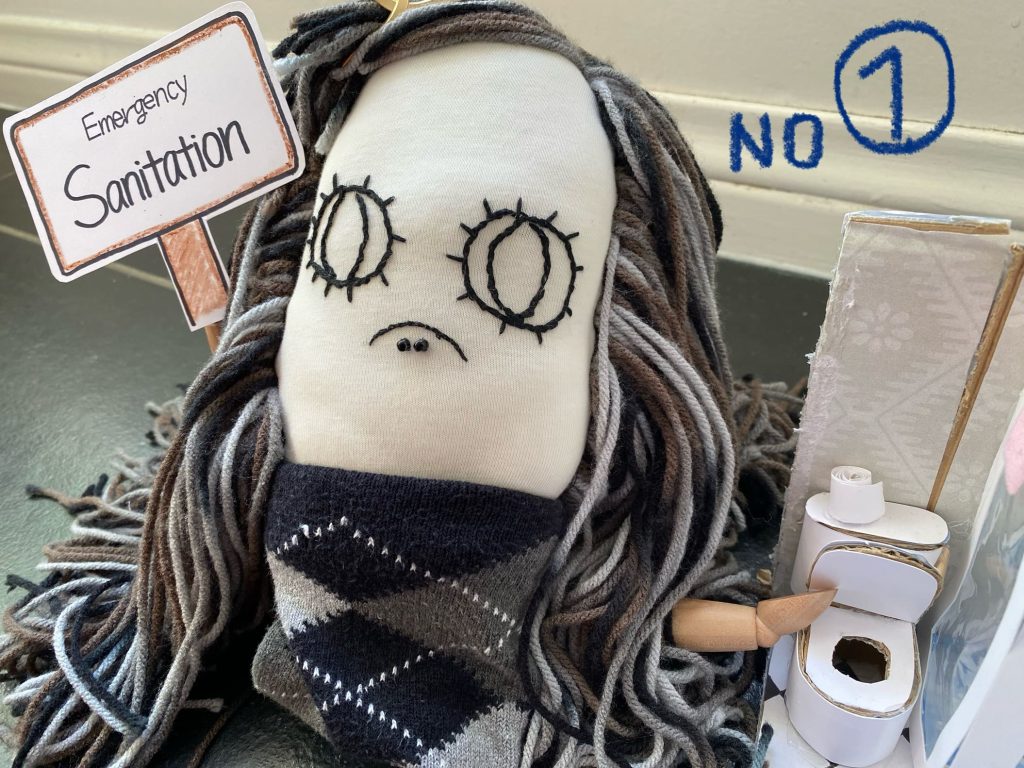
What should I know about preparing an emergency toilet?
“In the worst case scenario, I will just dig a hole and…”
“I always save water for flushing. I think I will be OK!”
“I will try to find restrooms at public parks, nearby.”
We must never forget about toilets when we prepare for emergencies. In and out! Drink and pee! Eat and poop! We can’t hold it all day! It is inevitable and unavoidable. Your bodily systems can require urgent attention, anytime and anywhere. After a major disaster, if you can use the restroom normally, consider yourself very lucky. But if not…
After a big disaster, we might have big plumbing problems. Water outages, toxic tap water, and clogged toilets can be caused by cracked pipes, shifted connections, debris lodged in sewer lines, or by a breakdown in larger plumbing and sewerage treatment infrastructure. And those are just a few examples of what can go wrong. Outages can last for weeks or even months. (Check out WaterOperator.org.)
Each disaster will be its own, unique situation, and the response will differ depending on the specific conditions. With a big disaster looming, even with advanced warning, many people won’t want to evacuate from their homes until the last minute. How many people can think about toilets at a time like that? I was in the Los Angeles area during the recent Southern California wildfires, and we almost had to evacuate. The fires kept coming closer and closer, and we were packed up and ready to go. We fully prepared to evacuate, but we decided to wait until the official order came. Luckily for us, the fires stopped advancing in our direction, and the order never came. Not once did we think about our toilet situation. We prepared drinking water, but I didn’t give a thought to how much water a family of four would need to flush toilets. It was a huge fire, and firefighters need water. Whole neighborhoods were without water pressure. So whether we stayed home or evacuated, we might not have had running water. I should have thought it through. (My heart goes out to everyone who lost their homes in the wildfires. A lot of people had to leave their homes for weeks, and many lost everything.)
A standard toilet needs 1.6 gallons (6 liters) of water per flush, according to the current federal standard in the U.S. Did you prepare this much water for flushing toilets in an emergency? (You can flush a toilet by pouring a large enough bucket of water into it. You knew that, right?) For me it’s difficult to keep a lot of water for toilets in my small apartment. So, it might have made more sense to evacuate and try to find an area with functioning toilets. But if we had stayed home, and were without water… it would have been a big problem, to say the least.
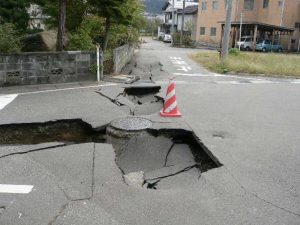
This web page details the damage to sewage services caused by earthquakes in Japan (including the Great Japan Earthquake of 2011): Osamu Fujiki Director of Water Quality Control Department.
During an earthquake, the shifting earth can damage pipes, joints, or connections buried underground. Sewer lines can easily crack. Check your yard for signs of sewer line breakage, like wet spots or seepage along the sewer line. Foul odors are another sign of sewage leaks. If you notice any of these signs, do not use your toilets or any drains. Remember to check for indoor plumbing leaks too, along floors, walls, etc. If your sewer line is broken, stinky sewage can back up into your home. You definitely don’t want that. You should wait for a professional plumber to assess the situation, and in the meantime, you’ll have to find another way to go to the bathroom.
This picture is from The Gentlemen Pros Plumbing, Heating & Electrical. Check out the link for a good explanation of why your plumbing can back up.
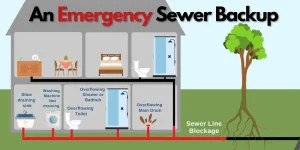
Here is another good diagram showing the sewerage from your home to the street. (From The MEP Academy)
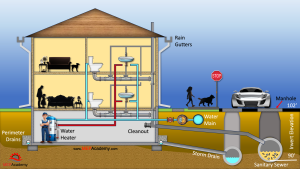
In the U.S., hurricanes and flooding cause more problem at wastewater treatment plants than earthquakes. If you have time to evacuate from your home, you should do it to avoid the burden of disruptions to wastewater systems. (Check out this page about disaster mitigation, on the EPA website.)
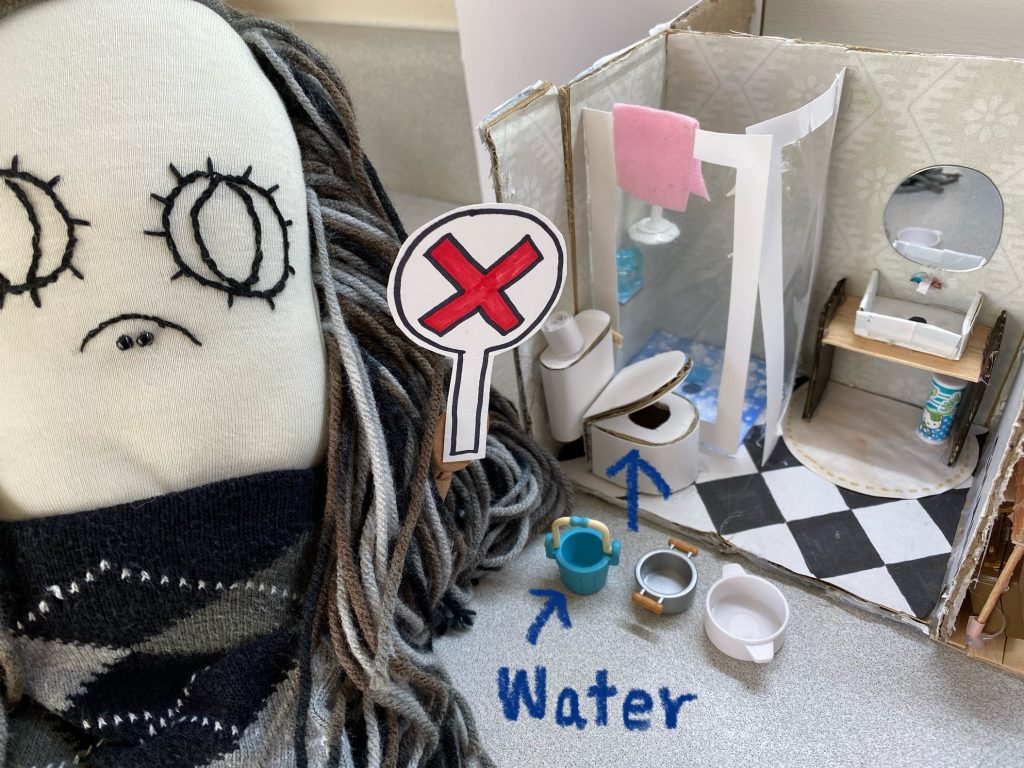
Do you know how many times you usually go to the bathroom??
On average, people urinate 4-10 times a day, but this will depend on the individual, how much fluid they consume, and other factors.
Urinary frequency depends on the following factors:
- age
- bladder size
- fluid intake
- alcohol and caffeine intake
- medical conditions, such as diabetes and urinary tract infection (UTIs)
- the use of certain medications and supplements
How about poop? Some people go twice a day, while others may do so three times a week. Actually how often a person passes stool can vary. This is a chart for stool frequency in the U.S. (from Medical News Today).
| Stool frequency | Percentage of people |
|---|---|
| 1-2 times a week | 3.3% |
| 3-6 times a week | 12.1% |
| 7 times a week | 53% |
| 8-21 times a week | 30.4% |
| More than 21 times a week | 1.2% |
Bowel habits depends on the following factors:
- age
- fluid intake
- activity
- diet
- medical conditions, such as inflammatory bowel diseases, celiac disease, and lactose intolerance
- hormones
- social factors (difficulty pooping in a public bathroom, like at work and at school; some people “hold it in” longer than necessary)

We can’t hold it! Our body needs the toilet. The toilet is like a part of our body. We need toilets all the time, everywhere. Toilet problems may not be limited to your home; they can include the neighborhood and beyond. Even if we can reach an evacuation shelter, we don’t know whether or not they will have a functioning toilet. I hope that it’s clear now why we need toilets in an emergency. I will show you what I prepared, toilet-wise, and more, in my next post.
See you next time.
Remember, “Protect your life by yourself” (自分の命は自分で守る). You need to survive first, and then you need your emergency supply. No matter how well you prepared your emergency supplies, if you die, then all of your preparations will have been for nothing. First and foremost, keep your health up all the time. Build your stamina so that if you need to, you can evacuate as quickly as possible. Stay healthy.